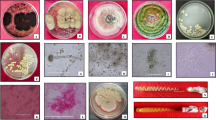Abstract
Diversity of Frankia isolates originating from lobes of single nodules collected on Alnus glutinosa root systems has been analyzed using isozyme electrophoresis method. Analysis of isozyme patterns showed no divergence among strains isolated from the same nodule. Each nodule (among 10 assayed) was inhabited by a single Frankia strain.
Similar content being viewed by others
References
Baker D and Torrey J G 1979 The isolation and cultivation of actinomycetous root nodule endophytes. In Symbiotic Nitrogen Fixation in the Management of Temperate Forest. Eds. J CGordon, C T Wheeler and D APerry. pp 38–56. Kluwer Academic Publishers, Dordrecht, The Netherlands.
Baker D and Torrey J G 1980 Characterization of an effective actinorhizal microsymbiont, Frankia sp Avcll (Actinomycetales), Can. J. Microbiol. 26, 1066–1071.
Benson D R and Hanna D 1983 Frankia diversity in an alder stand as estimated by sodium dodecyl sulfate polyarylamide gel electrophoresis of whole cell proteins. Can. J. Bot. 61, 2919–2923.
Benson D R, Buchholsz S E and Hanna D G 1984 Identification of Frankia strains by two dimensional polyacrylamide gel electrophoresis. Appl. Environ. Microbiol. 47, 489–494.
Bloom R A, Mullin B C and Tate R L 1988 Strain variation among Frankia isolates from root nodules of Myrica pensylvanica (Bayberry). In 7th international meeting on Frankia and actinorhizal plants. Connecticut (communication).
Bradford M 1976 A rapid and sensitive method for the quantification of microgram quantities of protein utilizing the principles of protein-dye binding. Anal. Biochem. 72, 248–254.
Callaham D, DelTredici P and Torrey J G 1978 Isolation and cultivation in vitro of the actinomycete causing root nodulation in Comptonia peregrina. Science 199, 899–902.
Chun P K, Sensabaugh G F and Vedros N A 1985 Genetic relationships among Neisseria species assessed by comparative enzyme electrophoresis. J. Gen. Microbiol. 131, 3105–3115.
Diem H G and Dommergues Y R 1988 Isolation, characterization and cultivation of Frankia. In Biological Nitrogen Fixation: Recent developments. Ed. N S Subba Rao. pp 227–254. Oxford and IBH publishing Co. Pvt. Ltd.
Diem H G, Gauthier D and Dommergues Y R 1982 Isolation and cultivation in vitro of an infective and effective strain of Frankia isolated from nodules of Casuarina sp. C.R. Ac. Sc. Paris 295 III, 759–762.
Dobritsa S V and Stupar O S 1989 Genetic heterogeneity among Frankia isolates from root nodules of individual actinorhizal plants. FEMS Microbiol. Letters 58, 287–292.
Faure-Raynaud M and Moiroud A 1983 Symbiose Frankia-Aulne: Culture in vitro de Frankia sp. sur différentes sources de carbone et d'azote. C.R. Ac. Sc. Paris 296 III, 757–760.
Faure-Raynaud M, Bonnefoy M A, Perradin Y, Simonet P and Moiroud A 1984 Protoplast formation from Frankia strains. Microbios 41, 159–166.
Faure-Raynaud M, Poirier-Bonnefoy M A and Moiroud A 1990 Diversity of Frankia strains isolated from actinorhizae of a single Alnus rubra cultivated in nursery. Symbiosis 8, 147–160.
Gardes M and Lalonde M 1987 Identification and subgrouping of Frankia strains using sodium dodecyl sulfate polyacrylamide gel electrophoresis. Physiol. Plant. 70, 237–244.
Gardes M, Bousquet J and Lalonde M 1987 Isozyme variation among 40 Frankia strains. Appl. Environ. Microbiol. 53, 1596–1603.
Gauthier D L, Diem H G and Dommergues Y R 1981 Infectivité et effectivité de souches de Frankia isolées de nodules de Casuarina equisetifolia et d'Hippophaë rhamnoïdes. C.R. Ac. Sc. Paris 293 III, 489–491.
Gauthier D L, Frioni L, Diem H G and Dommergues Y R 1984 The Colletia spinosissima Frankia symbiosis. Oecol. Plant. 5, 231–239.
Gonnet J F and Danière C 1989 Individual variation in the flavonoid aglycones excreted on the leaves of Alnus glutinosa (Betulaceae). Biochem. System. Ecol. 17, 239–247.
Goullet P H 1975 Esterase zymograms of Proteus and Providencia. J. Gen. Microbiol. 87, 97–106.
Lalonde M, Calvert H E and Pine S 1981 Isolation and use of Frankia strains in actinorhizae formation. In Current Perspectives in Nitrogen Fixation. Eds. A HGibson and W E Newton. pp 296–299. Australian Academic Sciences. Canberra
Lalonde M, Simon L, Bousquet J and Seguin A 1988 Advances in the taxonomy of Frankia: Recognition of species alni and elaeagni and novel subspecies pommerii and vandijkii. In Nitrogen Fixation: Hundred Years After. Eds. HBothe, F JdeBruijn and W EGustav. pp 671–680. Proceedings of the 7th International Congress on N = Nitrogen Fixation Köln (Cologne). Fischer, Stuttgart, New York.
Lechevalier M P 1983 Cataloging Frankia strains. Can. J. Bot. 61, 2964–2967.
Normand P and Lalonde M 1982 Evaluation of Frankia strains isolated from provenances of two Alnus species. Can. J. Microbiol 28, 1133–1142.
Pasteur N, Pasteur G, Bonhomme F, Catalan J and Britton-Davidian J 1987 Manuel technique de génétique par électrophorèse des protéines. Lavoisier ed. Tec. et Doc. 217 p.
Puppo A, Dimitrijevic L, Diem H G and Dommergues Y R 1985 Homogeneity of superoxide dismutase patterns in Frankia strains from Casuarinaceae. FEMS Microbiol. Lett. 30, 43–46.
Reddell P and Bowen G D 1985 Do single nodules of Casuarinaceae contain more than one Frankia strain? Plant and Soil 88, 275–279.
Saint Laurent X and Lalonde M 1987 Isolation and characterization of Frankia strains isolated from Myrica gale L. Can. J. Bot. 65, 1356–1363.
Simonet P, Normand P, Moiroud A and Lalonde M 1985 Restriction enzyme digestion patterns of Frankia plasmides. Plant and Soil 87, 49–60.
Simonet P, Thi Le N, Moiroud A and Bardin R 1989 Diversity of Frankia strains isolated from single alder stand. Plant and Soil 118, 13–22.
Steele D B and Stowers M D 1986 Superoxide dismutase and catalase in Frankia. Can. J. Microbiol. 32, 409–413.
Uriel J 1966 Méthodes d'électrophorèse dans des gels d'acrylamide agarose. Bulletin de la Société de Chimie Biologique 48, 969–982.
Young J P W 1985 Rhizobium population genetics: Enzyme polymorphism in isolates from peas, clover, beans and lucerne grown at the same site. J. Gen. Microbiol. 131, 2399–2408.
Author information
Authors and Affiliations
Rights and permissions
About this article
Cite this article
Faure-Raynaud, M., Daniere, C., Moiroud, A. et al. Diversity of Frankia strains isolated from single nodules of Alnus glutinosa . Plant Soil 132, 207–211 (1991). https://doi.org/10.1007/BF00010401
Received:
Issue Date:
DOI: https://doi.org/10.1007/BF00010401




